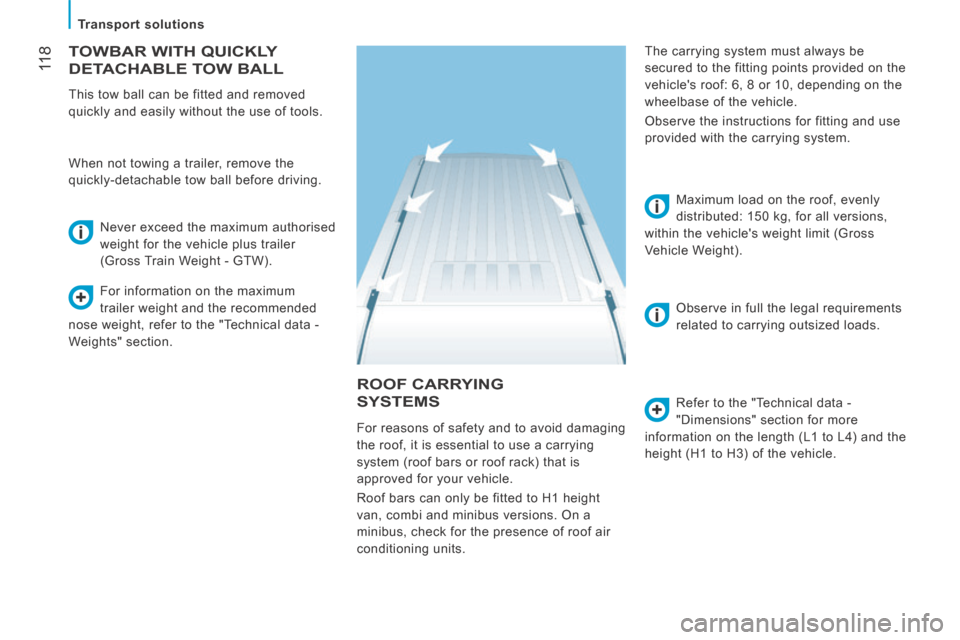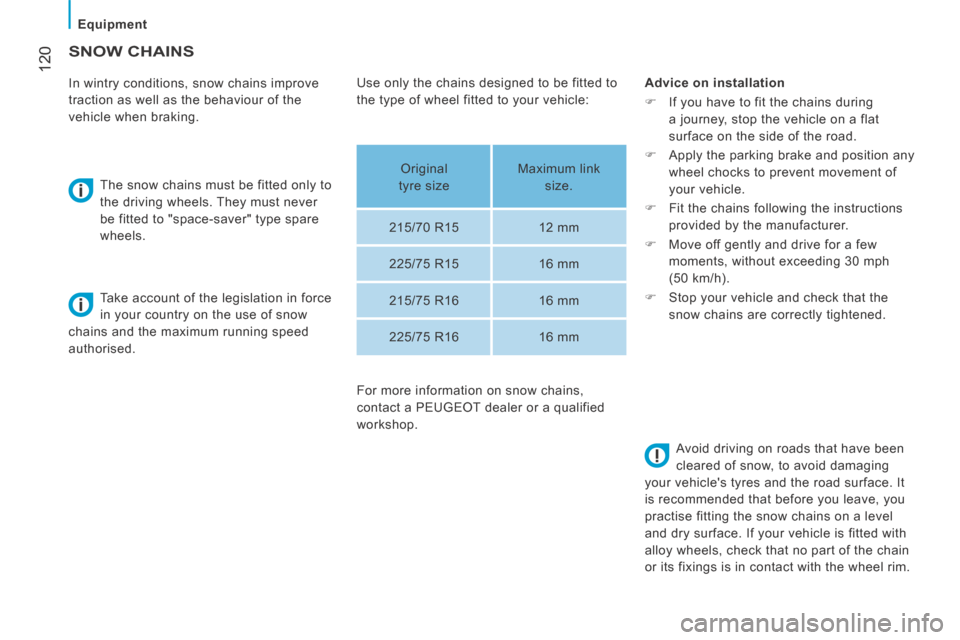Page 120 of 240

11 8
Transport solutions
ROOF CARRYING
SYSTEMS Refer to the "Technical data -
"Dimensions" section for more
information on the length (L1 to L4) and the
height (H1 to H3) of the vehicle. Maximum load on the roof, evenly
distributed: 150 kg, for all versions,
within the vehicle's weight limit (Gross
Vehicle Weight).
For reasons of safety and to avoid damaging
the roof, it is essential to use a carrying
system (roof bars or roof rack) that is
approved for your vehicle.
Roof bars can only be fitted to H1 height
van, combi and minibus versions. On a
minibus, check for the presence of roof air
conditioning units.
TOWBAR WITH QUICKLY
DETACHABLE TOW BALL
This tow ball can be fitted and removed
quickly and easily without the use of tools.
When not towing a trailer, remove the
quickly-detachable tow ball before driving. Never exceed the maximum authorised
weight for the vehicle plus trailer
(Gross Train Weight - GTW).
For information on the maximum
trailer weight and the recommended
nose weight, refer to the "Technical data -
Weights" section. The carrying system must always be
secured to the fitting points provided on the
vehicle's roof: 6, 8 or 10, depending on the
wheelbase of the vehicle.
Observe the instructions for fitting and use
provided with the carrying system.
Observe in full the legal requirements
related to carrying outsized loads.
Page 122 of 240

120
Equipment
SNOW CHAINS
In wintry conditions, snow chains improve
traction as well as the behaviour of the
vehicle when braking. The snow chains must be fitted only to
the driving wheels. They must never
be fitted to "space-saver" type spare
wheels.
Take account of the legislation in force
in your country on the use of snow
chains and the maximum running speed
authorised. Advice on installation
If you have to fit the chains during
a journey, stop the vehicle on a flat
surface on the side of the road.
Apply the parking brake and position any
wheel chocks to prevent movement of
your vehicle.
Fit the chains following the instructions
provided by the manufacturer.
Move off gently and drive for a few
moments, without exceeding 30 mph
(50 km/h).
Stop your vehicle and check that the
snow chains are correctly tightened.
Avoid driving on roads that have been
cleared of snow, to avoid damaging
your vehicle's tyres and the road surface. It
is recommended that before you leave, you
practise fitting the snow chains on a level
and dry surface. If your vehicle is fitted with
alloy wheels, check that no part of the chain
or its fixings is in contact with the wheel rim.
Use only the chains designed to be fitted to
the type of wheel fitted to your vehicle:
Original
tyre size Maximum link
size.
215/70 R15 12 mm
225/75 R15 16 mm
215/75 R16 16 mm
225/75 R16 16 mm
For more information on snow chains,
contact a PEUGEOT dealer or a qualified
workshop.
Page 165 of 240
163
9
TECHNICAL DATA
Vehicle identification
IDENTIFICATION MARKINGS
A. Manufacturer's plate
1 - VF Type serial number.
2 - Gross vehicle weight (GVW).
3 - Gross train weight (GTW).
4.1 - Maximum weight on front axle.
4.2 - Maximum weight on rear axle.
B. Serial number behind the windscreen
E. Serial number on the bodywork
This number is located under the plastic
cover, at the foot board on the right hand
side.
C. Tyres
This label (image given as an indication
only) affixed to the vehicle's door pillar, on
the driver's side, indicates:
- the tyre sizes,
- the tyre pressures, unladen and laden
- the tyre pressure for the spare wheel.
The pressures must be checked when
cold, at least once a month.
D. Paint code